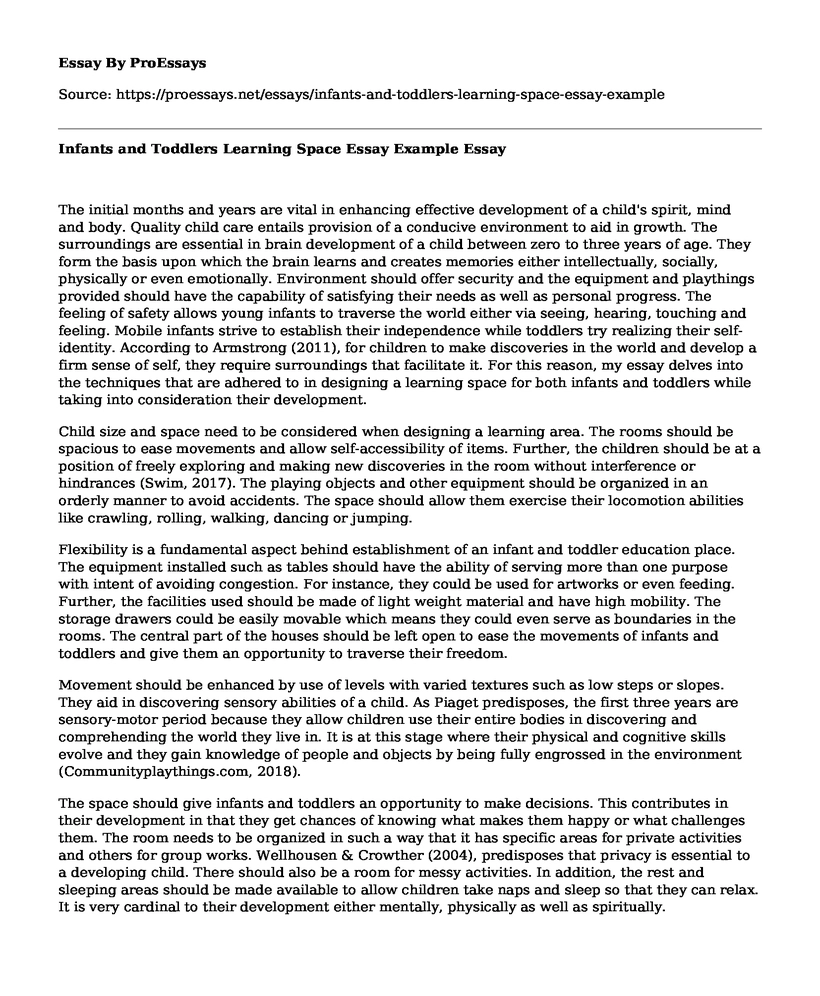The initial months and years are vital in enhancing effective development of a child's spirit, mind and body. Quality child care entails provision of a conducive environment to aid in growth. The surroundings are essential in brain development of a child between zero to three years of age. They form the basis upon which the brain learns and creates memories either intellectually, socially, physically or even emotionally. Environment should offer security and the equipment and playthings provided should have the capability of satisfying their needs as well as personal progress. The feeling of safety allows young infants to traverse the world either via seeing, hearing, touching and feeling. Mobile infants strive to establish their independence while toddlers try realizing their self-identity. According to Armstrong (2011), for children to make discoveries in the world and develop a firm sense of self, they require surroundings that facilitate it. For this reason, my essay delves into the techniques that are adhered to in designing a learning space for both infants and toddlers while taking into consideration their development.
Child size and space need to be considered when designing a learning area. The rooms should be spacious to ease movements and allow self-accessibility of items. Further, the children should be at a position of freely exploring and making new discoveries in the room without interference or hindrances (Swim, 2017). The playing objects and other equipment should be organized in an orderly manner to avoid accidents. The space should allow them exercise their locomotion abilities like crawling, rolling, walking, dancing or jumping.
Flexibility is a fundamental aspect behind establishment of an infant and toddler education place. The equipment installed such as tables should have the ability of serving more than one purpose with intent of avoiding congestion. For instance, they could be used for artworks or even feeding. Further, the facilities used should be made of light weight material and have high mobility. The storage drawers could be easily movable which means they could even serve as boundaries in the rooms. The central part of the houses should be left open to ease the movements of infants and toddlers and give them an opportunity to traverse their freedom.
Movement should be enhanced by use of levels with varied textures such as low steps or slopes. They aid in discovering sensory abilities of a child. As Piaget predisposes, the first three years are sensory-motor period because they allow children use their entire bodies in discovering and comprehending the world they live in. It is at this stage where their physical and cognitive skills evolve and they gain knowledge of people and objects by being fully engrossed in the environment (Communityplaythings.com, 2018).
The space should give infants and toddlers an opportunity to make decisions. This contributes in their development in that they get chances of knowing what makes them happy or what challenges them. The room needs to be organized in such a way that it has specific areas for private activities and others for group works. Wellhousen & Crowther (2004), predisposes that privacy is essential to a developing child. There should also be a room for messy activities. In addition, the rest and sleeping areas should be made available to allow children take naps and sleep so that they can relax. It is very cardinal to their development either mentally, physically as well as spiritually.
Conclusion
The learning environments should be designed in such a way that they ensure safety of the infants and toddlers. Spacious areas allow them to explore the world, gain self-identity and independence. Further, the furnishings used should have aspect of flexibility in their usage so as to save on space and avoid congestion. Enhancing movements via slopes and surfaces of different textures aids in sensory development. The areas should also be designed to depict home-like environment.
References
Armstrong, L. J. (2011). Family Child Care Homes: Creative Spaces for Children to Learn. New York: Redleaf Press.
Communityplaythings.com. (2018). [online] Available at: https://www.communityplaythings.com/-/media/files/cpus/library/training-resources/booklets/it-spaces.pdf [Accessed 26 May 2018].
Swim, T. (2017). Infants and toddlers: Caregiving and responsive curriculum development.
Wellhousen, K., & Crowther, I. (2004). Creating effective learning environments. Scarborough, Ontario [u.a.: Nelson Thomsen, Delmar Learning.
Cite this page
Infants and Toddlers Learning Space Essay Example. (2022, Jun 06). Retrieved from https://proessays.net/essays/infants-and-toddlers-learning-space-essay-example
If you are the original author of this essay and no longer wish to have it published on the ProEssays website, please click below to request its removal:
- Child Development Observation Paper Examples
- Legal Implications: Unpaid Internship for International Students Essay
- Paper Example on Parental Incarceration Impact on Child Behavior
- The Practice of English Language Teaching Essay
- College Education Should Be Free - Persuasive Essay
- Create SMART Goals & Milestones for Success: Essay Sample
- Essay Sample on Workaholism in College: How to Avoid its Lasting Effects







